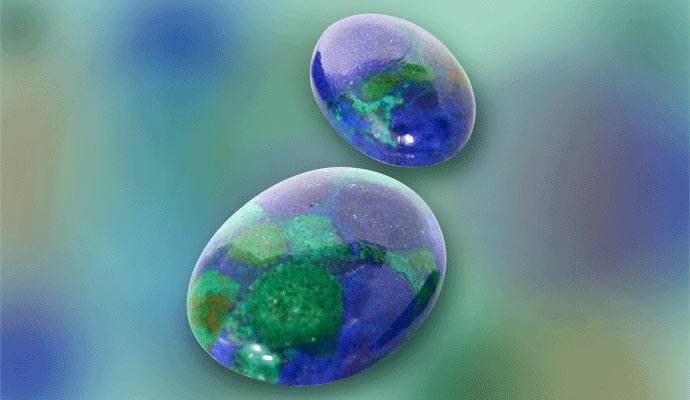|
Gemstones
Articles from GEMSTONES - LOOSE (254 Articles), GEMSTONES - SYNTHETIC (54 Articles), GEMSTONES - CHRYSOPRASE (40 Articles)

Azurite
The lure of azurite
Azurite is a basic copper carbonate named after its deep blue to bluish-purple crystals - azure derived from the Persian word lazhward, meaning blue.
The distinct azure shade is due to the presence of copper and its colouring effect on carbonates and hydroxyls. Found in many parts of the world in the upper oxidised portions of copper ore deposits, azurite is usually located near malachite, the green basic carbonate of copper. The two often appear in one stone in an appealing blue-green pattern called azure-malachite.
Azurite usually forms as small crystals in prismatic, tabular, or equidimensional form and are frequently striated. Other forms include massive, crusty, radiating, fibrous, columnar, stalactitic, thin needles and in ball-like aggregates. Azurite also occurs in dense groups of tabular or prismatic crystals.
The softness of azurite means it can be easily damaged and should be handled and stored carefully. Occasionally, it is coated with colourless wax, or sometimes even impregnated with plastic or other hardened agents to improve its durability and appearance. Azurite should never be cleaned with any product containing ammonia, as this will remove the stone's polish. Caution is also needed when cutting or carving azurite, as its dust is moderately toxic.
Due to the friable nature of azurite, it has not been extensively worked as an ornamental stone. However, some unusually tough samples were recovered from the Copper World Mine, near Las Vegas, in 1971, and it became a popular lapidary material and was christened 'royal gem azurite'.
The distinct blue colour of this gemstone has made it an ideal material from which to make paint and fabric dyes. The process began centuries ago in Fourth Dynasty Egypt (2575 - 2467 BC), but did not become common until the Middle Ages and Renaissance era, when azurite was the most important pigment in European painting. It was possibly one of the blues Michelangelo used to paint the Sistine Chapel.
Eventually, however, it was abandoned, as people realised certain environments turned the azurite into malachite, and horrified artists saw their masterpiece skies and seas turning green.
Azurite has been revered for its healing powers, with its high copper content believed to stimulate the thyroid gland and help heal sinus problems, throat disorders, spinal alignment problems, circulatory disorders and spasms.
As an aid in psychic and intellectual development, azurite is claimed to have a balancing effect on the left and right sides of the brain, awakening intuition and awareness. Some believe it is wise to place a piece of azurite on a part of the body where there is a feeling of congestion or blockage.
Various cultural traditions and beliefs exist about azurite. The Ancient Greeks called it caeruleum and used it extensively in healing ceremonies. Native Americans considered azurite a sacred stone and used it to connect with spirit guides. American legend claims azurite is one of the most powerful healing stones, and in other traditions, it is treated as a stone of high status.
fact sheetAzurite
Hardness: 3.5 - 4
Variety of: Copper carbonate
Found: Australia, France, Namibia, Romania, Russia, Siberia and the US
birthstonesNovember birthstones
Modern: Yellow topaz
Traditional: Citrine
Mystical: Pearl
Ayurvedic: Topaz
Zodiac birthstonesScorpio (October 23 - November 21) Aquamarine/Topaz
Sagittarius (November 22 - December 21) Sapphire/Amethyst
Posted November 01, 2005
|
|
|
|